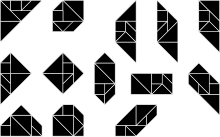 The tangram is a game whose origine is Chinese. It is formed by seven poligonal flat pieces, generally
made by wood, with which it must create
figures without overlaping them. In the early 19th century it was carried
over to Europe, and it became very popular in the continent for a time then,
and then again during World War I. It is one of the most popular dissection
puzles in the world.
The tangram is a game whose origine is Chinese. It is formed by seven poligonal flat pieces, generally
made by wood, with which it must create
figures without overlaping them. In the early 19th century it was carried
over to Europe, and it became very popular in the continent for a time then,
and then again during World War I. It is one of the most popular dissection
puzles in the world.
The tangram provides lots of benefits: it promotes the development of intellectual and psychomotor abilities, stimulates the creativity and the formation of abstract ideas, fosters the logical-mathematical intelligence, improves the eye-hand coordination…
There are only thirteen convex shapes matched with the
tangram set. Children must take into account, for example, in the
equivalence of several pieces, gathering
the two small triangles, learners can build the square, the rhomboid or the
medium triangle…
Primary students can play with
the tangram to differentiate the area
and the perimeter; in this way the would understand that a same area is not
equal to the same perimeter. In my practices stage I could observe that
misconception, some children believed that two polygons with the same area had
the same perimeter, and I had to show them that they were wrong. I gave them an
example so that they could understand in a notebook, but the tangram is the
best tool in order to solve this problem, in my opinion.
An entertaining activity for any cycle would be to give freedom to learners so that they create the figures they want; thus they foster their imagination and
creativity. Once they have formed it, they could measure the perimeter and the area, and they could correct the misconception I have detailed in
the previous paragraph.
Playing with they tangram is
very enjoyable for Primary children. They can practice and play with a didactic
tool in an funny way while they are learning meaningful concepts about the
measurement. Without any doubt, a great invention.

No hay comentarios:
Publicar un comentario